Just off Peoria Avenue and 11th street in Tulsa, Oklahoma, on a clear midsummer morning when the temperature is already 83 degrees and the forecast passes 100, a sign for Meadow Gold milk and ice cream holds to scaffolding atop a large brick shelter, an historical monument. Sunlight hits the roofs of nearby buildings while empty streets are still shadowed. I am the only one here. Yes, this is a tourist stop but it’s still very early.

Concrete inlays tell me I am on Route 66, the Mother Road, the source for the American Road Trip Dream. While a part of me is elated, thrilled, ready to hit the gas, shift some gears, burn some rubber and squeal, a part of me keeps looking around for something else. There should be more, I think. Some flourish or flash. I’m not quite sure what it is. A Cadillac with tail fins. A convertible Corvette. Something that screams both innocence and adventure.
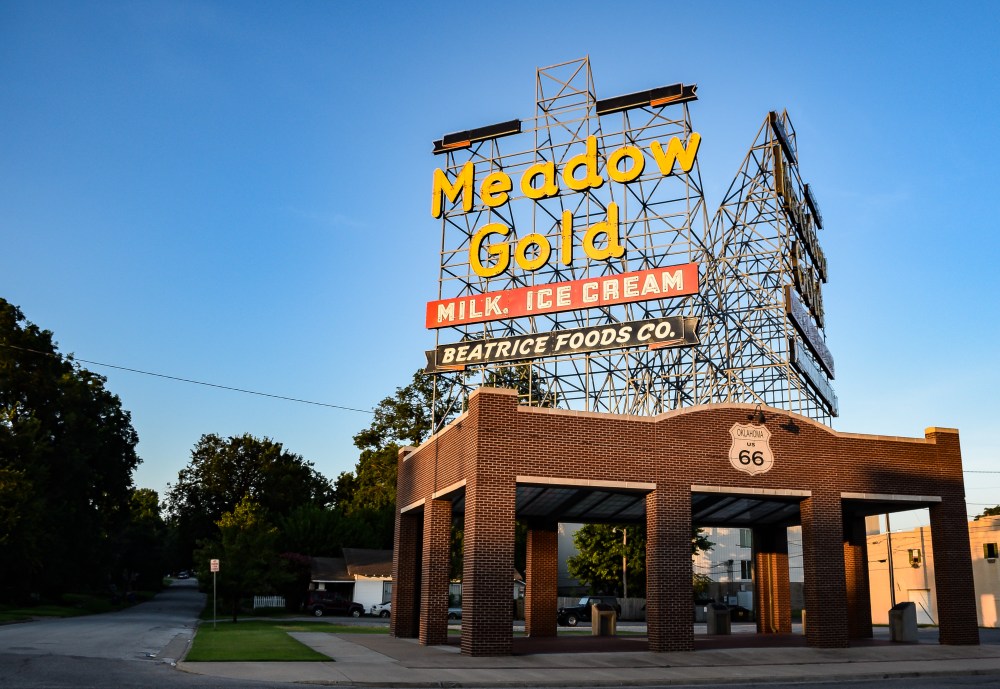
But queue the road music anyway. Something from the early 60’s, summertime fast. There’s a theme song for this:
If you ever plan to motor west,
Travel my way, take the highway that is best.
Get your kicks on Route sixty-six.
This is the beginning of my day’s adventure. Route 66! Ten minutes before 7 in the morning, sunrise heat already causing the air to shimmer, and I have a thousand miles to drive today. A bit more, if I’m lucky. My hope is that this day will end in Phoenix, Arizona, at my brother’s home, a 16 hour drive I‘ve done before. But this time is different.
This time I can stop if I want. This time, I can linger at the sights. I can talk to strangers. I can wonder toward the edges of anything. I cannot say I am here because of this road. But now that I’m here, it’s the road that matters.
Roll the windows down, I think. Turn up the music. It’s time to go.
***
I am old enough to remember the television show: Route 66. Two young men, Tod and Buz, drive their convertible Corvette in a show inspired by both The Naked City and Kerouac’s On The Road. It was a Beat Generation dream, every week a new adventure. Most episodes were not set on Route 66, but that did not matter. Route 66 is more idea than pavement. Maine to California, this show was the road trip epic. Anything could happen. This was American youth searching for meaning. Odd temporary jobs. Odd people searching for more. Anything could be dangerous or romantic. Shrimpers. Heroin addicts. Hollywood stars. Anything could be anything at all.
Laying on the floor, my pre-driving self watching the black and white television, I’m sure I held my breath.
What happened one week had little bearing on what would come later, had little dependence on what happened the week before. This was the genius of the show and a truth about the road. It was random, frivolous in causality, serendipitous, alluring. Tod and Buz met everyone and seemed to come out pretty well.
Route 66 became a metaphor for everything possible and everything good. Freedom. Self-Reliance. Adventure. Empathy and wonder and hope. Yet here is what I believe. Route 66 was the moment we lost it, too. At that moment, watching the show, we felt the need to recover something, to go back somehow. Not really back in time—but back to some alternate self, to who we felt we could have been, were meant to be, should have become if only the reality of reality had not directed our lives away.
The road wasn’t simply famous. It wasn’t just the Indy brickyard or the Alaska Highway. Maybe it was the song. Maybe the show. But Route 66 became a goal for everyone, the icon for both speed and distraction. Most of us would never get there. If we’d been there, we could never get back.
To drive the whole length, from Chicago to Los Angeles, is a common desire for people who love the road, who love to drive. To drive the whole length and pretend we are Tod or Buzz, or to touch the places the famous—Elvis, Frank Sinatra, Marilyn Monroe—touched in their own quest to get some kicks, is a way to change the way we see our lives.
In short, we are nostalgic for the Route 66 we believe once existed, a road we have always imagined but never driven. A road we never saw, never felt with our tires or legs. We are nostalgic for a memory that is not our own. It’s just an idea, a bit of desire, a siren calling while we’re tied to the mast.
And so, if the opportunity comes, we roll down the windows and press on the gas, even today, hurtling backward in time. We want the road today to change our past. This is the mother road, the source for the American Road Trip Dream.
***
I’ll admit it. I want kitsch. I want art deco. I want cheesy roadside attractions and diners built of chrome. I want all that stuff today. I have no idea why.

My first car was a Mustang. It was used, weary, broken in a hundred ways, and the most wonderful thing I had ever imagined. It did not last very long. But I can say it has lasted forever. It gave me a romance, a love that persists. This road leads somewhere. This bend will straighten, then bend again.
I have driven from Key West to the Beaufort Sea, chased storms in Colorado and the northern lights in Minnesota. I have hurtled through midnight river bottom fog in Missouri, crested mountaintops from Mount Evans to Mount Washington, seen mid-day sun in Death Valley and endless twilight on the Trans-Canada highway. I have steered into blizzards and windstorms, crossed black ice and sudden rockslides. I have a lifetime of prairie roads, gravel and broken pavement as well as fresh-made Interstate Highway, always at speed, sometimes a little and sometimes a lot too fast, radio loud and always happy. But I have never driven Route 66.
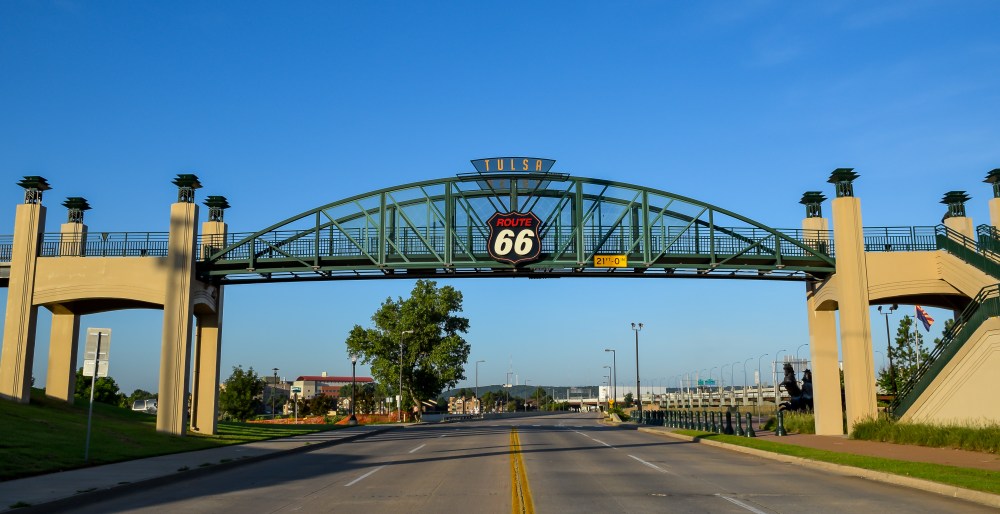
There’s a sweeping blue and yellow arc over the road out of Tulsa. All it says is Route 66. Yes, it says, you are on that road. There’s a large sign on an overpass. Route 66! There’s an imitation Oklahoma oil rig. Route 66!

It’s all over the top. And frankly, it’s all amusement-park fun. It doesn’t seem real, but I am smiling big. There is a metal roadside sculpture that shows a horse and buggy confronting an ancient Ford. The horses are rearing, afraid and ready to bolt. The husband and father driving the Ford leaps from the car to take on the horses while the wife and mother turns to protect and comfort the daughter in back. The sculpture is very good. One era and then the other. This is where it began, I think. Not this place, of course. This moment.
***
Nostalgia is a desire for the past, a desire for the unrecoverable, a wish to start over and do it all again, knowing what we know, having been there once before. It’s impossible. It’s also knee-rattling and breath-stealing real. It can be a type of sorrow, perhaps a type of mourning for what we missed. It can also be the deep satisfaction of perspective, a looking back with wisdom, the joy of finally understanding.
If only, we think. If only we could go back. Tune the radio to an oldies station. Put a cuff in your jeans.
It seems there is a way to reach back, to wait, to see the future arrive and then decide what to do in the past. In physics, it’s called the delayed choice experiment, or the double slit experiment. Helium atoms, which exist as both wave and particle, are shot through a laser screen and observed in their particle form. But when a second gate is introduced, a screen a bit farther downstream—in the future, if you will—then the atoms are observed in their wave form, at the first gate! In other words, what happens in the future changes the form of the past.
God love physics, I think. Today is the past’s future. What happens today changes what I remember, what I claim I felt, the focus on what I saw. What happens today changes the facts on every road I have ever driven. It’s all delayed choice.
A love for the road is, more than anything else, an appreciation of distance. Between here and there. Between then and now. Between what we remember, what we wish, and a universe that proceeds without us. There is a hope we will catch up.
***
Up to speed on the highway, zippin’ along, I look over at the guidebook on the seat next to me. The Route 66 Adventure Handbook—Turbocharged Fourth Edition. Every town has some attraction, some curiosity or bit of this-used-to-be to stand in front of and wonder what you missed. It’s an odd way to define adventure.
There’s a 76-foot giant oil worker sculpture, known as the Golden Driller, standing outside of the International Petroleum Exhibition (IPE) Building at the Tulsa Fairgrounds. The IPE is said to contain the world’s largest unobstructed interior volume.
Or—
Also in Tulsa you’ll find the Center of the Universe, a sort of acoustical mystery spot downtown. Stand in this spot, recite come words, and you’ll hear your voice strongly reverberating back to you. The effect is quite striking.
Or—
You can’t see it, but along the stretch of road between Bristow and Stroud, there is an enormous underground storage cavity—a depleted gas field—which is used for storage of natural gas during periods of surplus. What you can see is that there are at least three cemeteries along Route 66 between Bristow and Depew, and then there are two more west of Depew, where 66 approaches the Turner Turnpike (I-44).

I decide to skip the Round Barn in Arcadia, as well as the 66-foot tall lighted bottle of soda-pop. I skip Lucille’s gas station in Hydro, Oklahoma, even though the guidebook tells me that Lucille, the real person, was the mother of the mother road. She took time to talk to her customers.
But there is a Route 66 museum in Clinton. I pull over, turn off the Jeep, and sigh. Across the street is the Trade Winds Inn. The guidebook tells me this place was a good day’s drive from Memphis and thus one of Elvis’s favorites. He always stayed in Room 215, which is still available by reservation.
The museum begins and ends in the gift shop, which is no surprise. Route 66 mugs and t-shirts and key chains and souvenir highway signs. The exhibits include an old, black and white Oklahoma Highway Patrol car, a sign promoting an opportunity to see Live Poison Rattlesnakes, four red and chrome stools in front of an imitation diner counter, an imitation diner booth. There are old license plates, facsimile menus, newspaper clippings, old clothes and older pictures. A sign for RC Cola and a sign for a Sonic Drive-In.
Men and women move through slowly, quietly. No one talks. It’s all a bit mysterious. No one seems particularly reverent—this is not the circle tour of Notre Dame or Sacre Coeur—but no one seems overly profane either. It’s like everyone is trying to find a way in. Almost everything is a replica. This is not what it was. This is what it was, was like.
I hurry through. In the gift shop, though, I feel a need to take something away, something solid from the museum. I like coffee, so I buy a mug with the Route 66 highway sign on the side. The logo is slightly crooked.
***
It’s easy to see. Nostalgia is fully embedded in the present. It is the moment we realize the weight of history, of something good or hard in the past, makes our heart leap now. It might be our own memory. Or it might be the way we see, oftentimes suddenly, a moment in some other life that carries the weight of our own universe. It might be a sight, a sound, a smell, a touch—utterly fresh and completely new—that rises to speak for something we remember or dreamed.
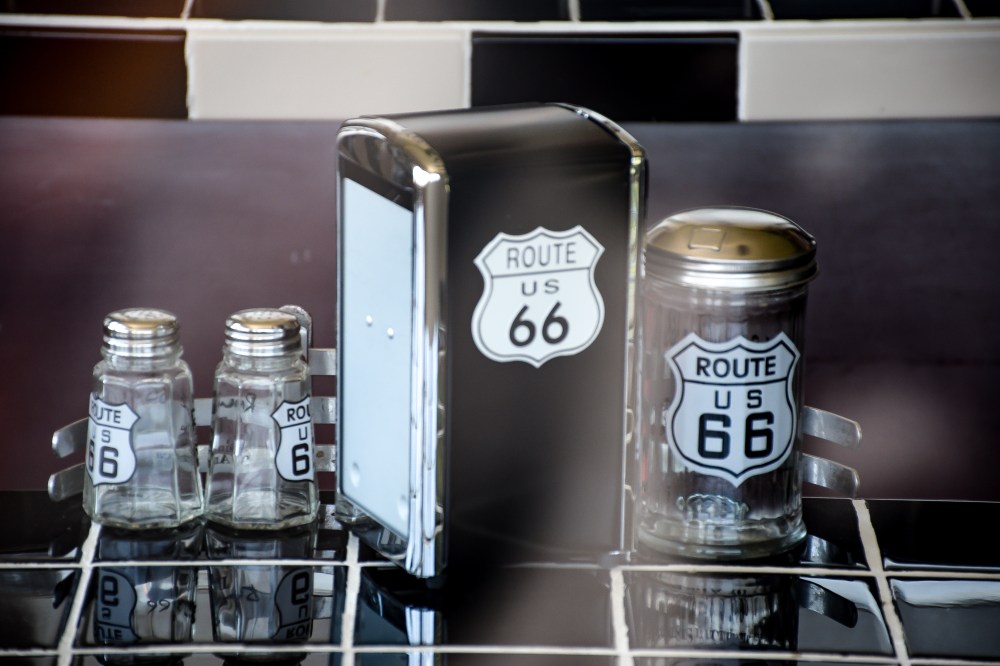
Memory always colors the mood of now. But here is the thing—it is not the memory that makes us smile or cringe. It is the distance, the historical space between that moment and now which causes us joy or pain. It makes no sense, but there is a whisper in our ear and we feel as if we could remake our past with the knowledge of our present. We just don’t know how to get there. We don’t know how to go back, though we feel we must.
This much we have on faith. There is hope for our mistakes, the things we have lost, the moments we have loved. We take what we learn today and cast it backwards.
***
Outside the Route 66 Museum there is a small Valentine diner. Teal gray with red trim, it advertises hot dogs, fries, burgers and ice cream. My guidebook tells me it used to operate in Texas, was then restored and moved here. This, I think, could be fun. I imagine sitting at the counter, Buddy Holly on the radio, a burger and fries and a strawberry milkshake in front of me. I imagine a waitress, bored and chewing gum and wanting to be anywhere other than a small diner in Oklahoma because she’s been to the movies and dreams of Los Angeles or New York or Paris, or even Kansas City. The door, however, won’t budge.
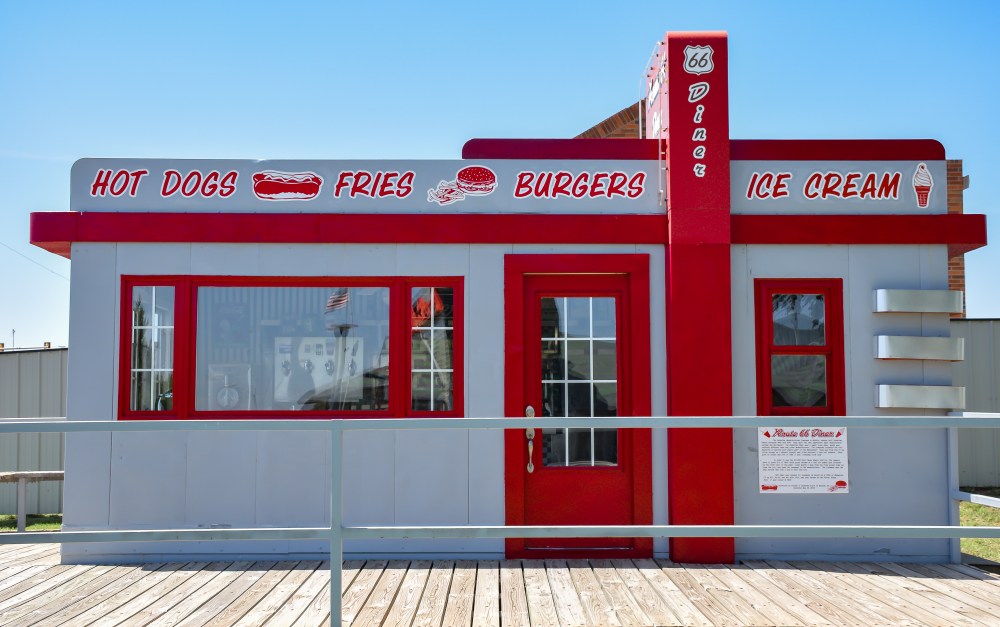
Of course, it’s closed and locked up tight. I press my hands and face to the window. The salt and pepper shakers, the sugar jar, the napkin holder all boast the Route 66 logo. But they are all empty. There is no way to get in.
Here, I think is a sad truth about Route 66. This is not a diner. This is a display of a diner. I can admire only a replication of what used to be, and what used to be somewhere else.
In the parking lot, I look across the street at the Trade Winds Inn. I have nothing against Elvis, but I’m not a big fan either. What I want is more of today. To be more in today. I get in my Jeep and motor west.
***
Nostsalgia. The word, at first, described a malady. Seventeenth century Swiss soldiers could not bear the stink and filth of death. World War One soldiers remembered home so bodily they could not face the trenches. But it wasn’t just a homesickness, a clinging to some romanticized past. There was always something deeper.

Nostalgia is a perception that the past has a way of lingering. A premonition that what happens today alters the color, the mood, the taste of our history. But time works in both directions. In that distance of looking back, there is something that brings motivation, desire. Something that reveals our hope.
***
I cross the border into Texas. I pass two or three more Route 66 museums. I pass tumbleweed, too. I pass a fragment of the real Blarney Stone from Ireland. I pass the U Drop Inn.
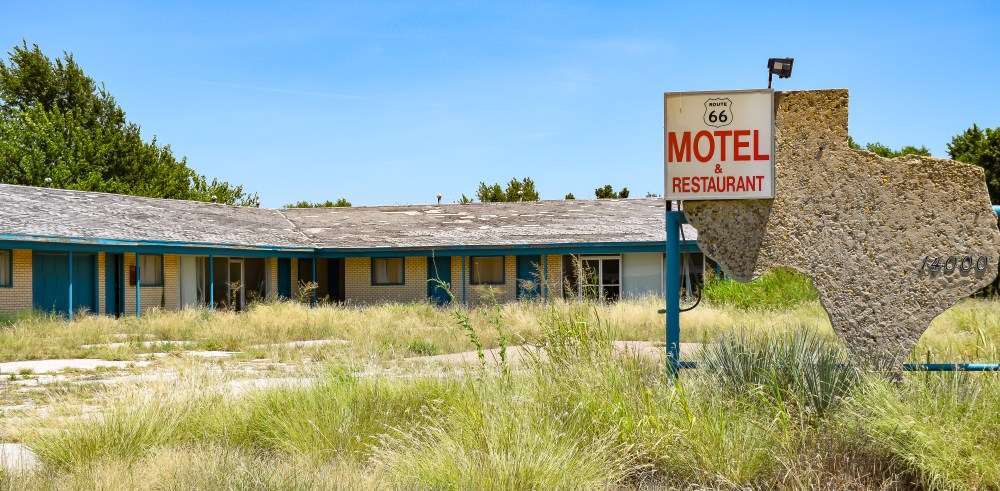
It feels good to have the Jeep up to speed, to be making some distance, making some time. There’s classic rock on the radio and this, I think, is road joy. To be moving. Even though the music is old, I’m hearing it today. I am in today. I am in the now. The future is right there, only a few feet in front of me, visible in the shimmering light and the waves of heat lifting off the highway.
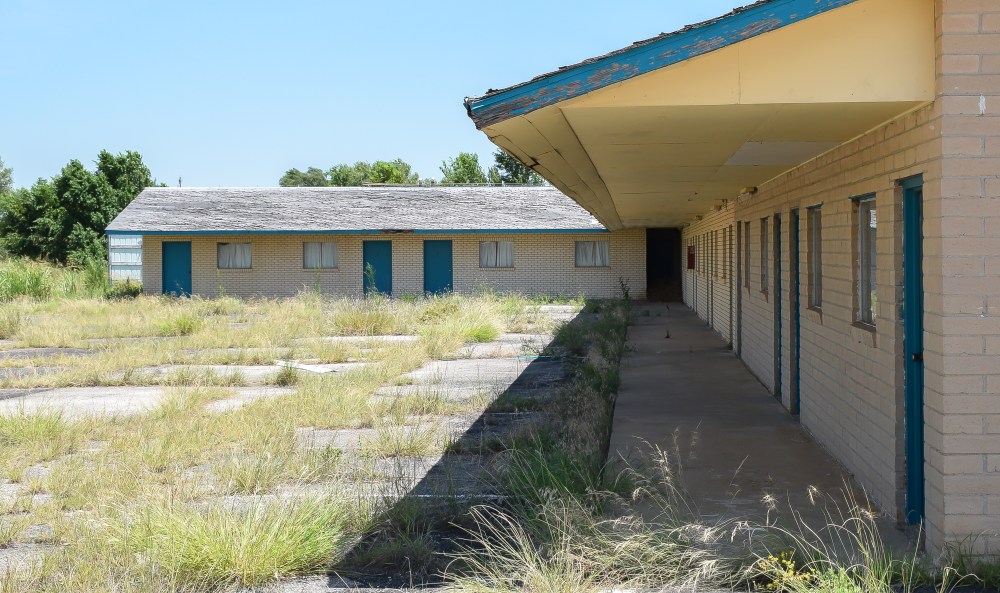
In McLean, however, I stop at the Texas Motel and Restaurant. Long derelict, weeds growing through the pavement, signs faded and broken, this is the most real thing I’ve seen today. This is not a replica of the past. This is the past, somehow persisting into this day. I get out and wander around the parking lot, peer in the windows. I have no idea who stayed here, but the ghosts are loud.
There is a difference between a display and a ruin. Even the broken pull-chain for a curtain is an artifact here.

I am tempted to try a motel room door. I wonder what would remain. Bedframes? A forgotten coloring book? I wonder if there are Gideons in the debris. But either out of fear or respect, I do not.
few hundred yards later I stop again at an old service station. Route 66 Motors, the sign says. It’s equally derelict, overgrown, wonderful and sad. Hot Rod Haven is long closed too. It’s easy, and somehow pleasant, to put my hand against those walls and think: This is who you’ve become.
The restored gas station—closed to everything except looking at it, of course—and the sign promising rattlesnakes don’t call to me at all.
***
In the town of Groom, Texas, the guidebook promises me a water tower that leans like it’s in Pisa, Italy. I pull off the highway and yes, there is a leaning water tower. According to the guidebook, the owners of the truck stop thought a leaning water tower would be a good gimmick. I take a picture and hit the gas.

Outside Amarillo, I stop at the Cadillac Ranch, ten automobiles in a row stuck nose first into the ground. Men and women and very young children armed with cans of spray paint climb on them, into them, around them, and spray their marks. There is so much paint in the air I worry about my clothes and my breathing. Desecrating the automobile in a field just off the mother road—or, to be exact, just to the side of an Interstate highway that replaced the mother road—makes me wonder.
***
Soon, I stop again. This time in Adrian, Texas, the Route 66 halfway point. Halfway between Chicago and Los Angeles. 1,139 miles in either direction. The landscape in every direction is flat and hard.

The Midpoint Café is open, but not at the moment. It closes shortly after lunch and I am simply too late. Likewise, The Bent Door Station (named for a blue door taken from an airport control tower, bent at the middle to match the shape of the tower cab) is closed. The Fabulous 40 Motel is closed. Neither the station nor the motel have seen customers in some time.

I stand in the middle of the street. A white stripe is painted on the road. I look one way and then the other, smile when I remember that Janus, the Roman god of beginnings and endings, was also the god of doorways, time, gateways and transitions. There should be a small temple here. That would be some kitsch.

The metaphor does not escape me. I’m in my own 50s now. My own midpoint. I love the road, am late for lunch and still have a long way to go. Every moment of this day rearranges the way I understand my past.
So, yes, quantum physics contradicts general relativity. And the world we move through every day, our desks and gutters and evening meals are governed much more by relativity than quantum forces, but in my life at least, small scale reality and large scale reality do not need to agree.
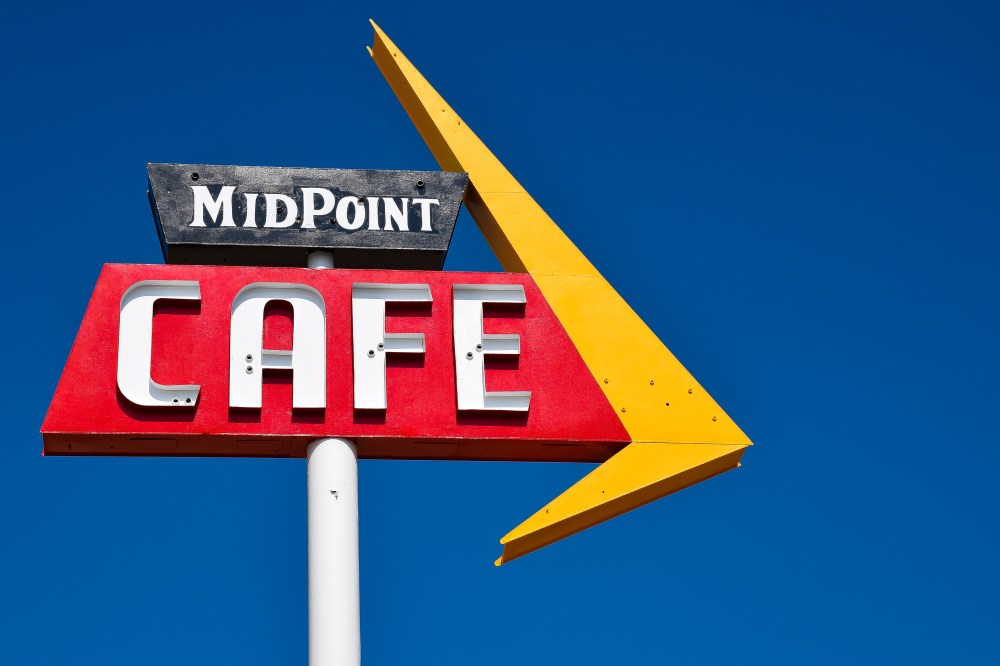
Nostalgia is nothing less than a love for the size of time. We have been on the road, our soul says. We remember the thousand places this story begins, and we are awake enough in the present to know the road has changed us. When we are changed today, our past changes too. We see something wonderful or hideous or shadowed or true. We remember or we hope, the private and intimate shape of our history, beginning and end. We appreciate the cosmos in between.
Yet here is the thing. We know what past we have. We can change its taste, revisit shadows and echoes we caught but didn’t pay attention to. We can pretend we were someone other than we were. Think of the Helium atoms, the double split, the delayed choice. Yes, the present effects the way we see the past. We marvel at the change from seeing particles to waves. How wonderful is that second gate, though. A small introduction, today, that changes everything. What other gates are coming, I wonder? What joy and promise in the future coming now?
Back up to speed, I feel the call of an ever-receding destination. I decide I will stop for gasoline and coffee. I will stop to look at Meteor Crater, too. I know it’s just a hole in the ground, but it’s an extraordinary hole that reveals a bit of the cosmos. I will not stop for anything less.
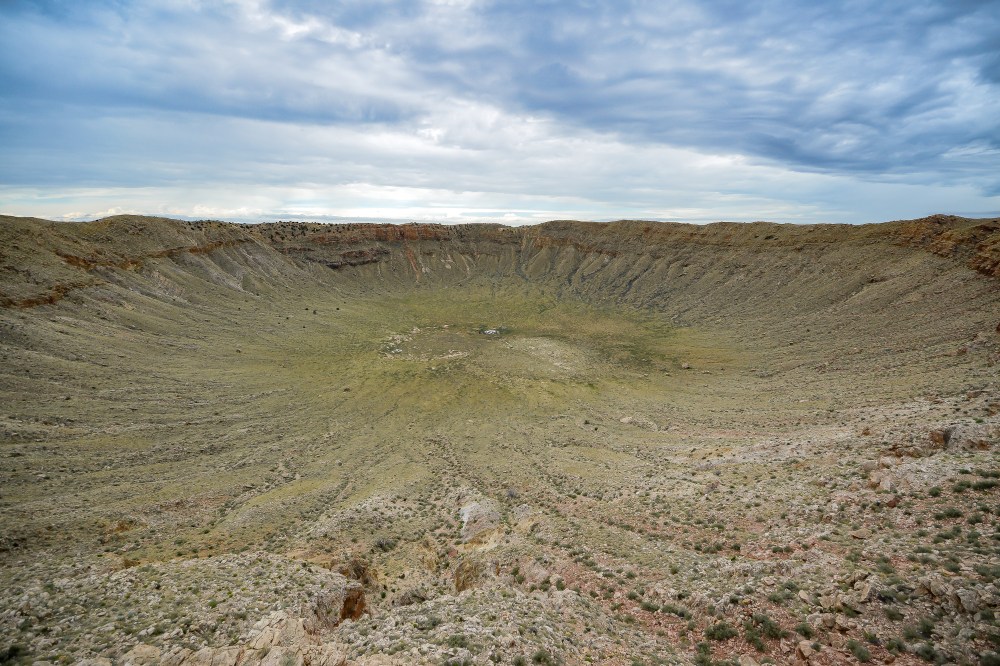
~
W. Scott Olsen’s eleventh book, A Moment with Strangers, was published in 2016. His travel and adventure essays about road trips and flying small airplanes have appeared widely in literary and commercial journals. Professor Olsen has edited two anthologies and also edits the international literary magazine Ascent.

